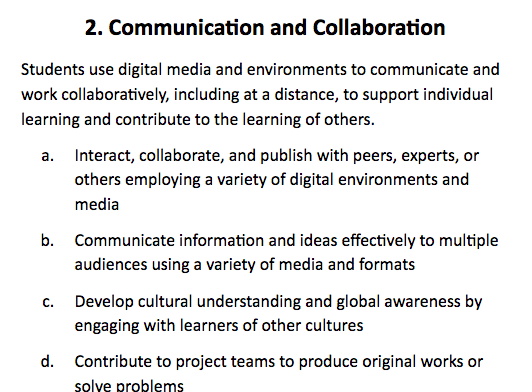This week we focused on ISTE standard 2, which states, “Students use digital media and environments to communicate and work collaboratively, including at a distance, to support individual learning and contribute to the learning of others.” I decided to focus on portion D of this standard. Part D says that student’s will, “Contribute to project teams to produce original works or solve problems.” To me standard two pushes students to use technology as an avenue for a different type of student collaboration that may enhance a collaborative experience. I focused in on portion D because in younger grades the main source of collaboration stems from problem solving and explaining their thinking.

Our class trigger question was, “How can students use digital media and environments to communicate and work collaboratively, including at a distance, to support individual learning and contribute to the learning of others?” This made me think about the more specific question of, “How can I find a resource that is easy enough for students use without parent help and wouldn’t worry parents as students interact and collaborate during a learning task?” I began my exploration by reading Megan Cicconi’s article, “Vygotsky meets technology: A reinvention of collaboration in the early childhood mathematics classroom.” This article shared Vygostky’s theory about student interaction and the benefits of using online interaction. She states Vygotsky’s research and findings when it comes to online participation as well as points out the three main benefits. These benefits are, “First, they found that the virtual world allows students to complete tasks that would other-wise be improbable due to realistic constraints, including money and time…The second benefit that Antonacci et al. (2008) identified is the virtual world’s persistence and constant accessibility, which increases social interactions and therefore provides more opportunities for collaborative learning…The third benefit of utilizing virtual worlds for collaborative learning that Antonacci et al. (2008) discovered focuses on the adaptive and emergent nature of virtual worlds.”All of these benefits are not only specifically found in online collaborative learning, but are indeed met by this process!
Cicconi’s reading led me to my resource of Voki and helped me answer my question for the week. I was worried about having students be monitored while being online/ having parents feel secure as their students work collaboratively. Cicconi’s article made it clear that there are many resources that are available that teachers can manipulate depending on what to do, who can see it, and how students may and may not interact. She states that teachers may control, “student-initiated publishing and sharing, utilizing privacy controls and creating pairs, small groups, or whole group activities based on objectives and projects, and allowing students to interact through teacher-selected social network sites.” This affirmed my question of how to keep online collaboration within a safe environment. After that question was answered I was pointed to a resource by the name of Voki. This is a website that allows students to make an avatar and share their ideas through that avenue. Students can retell a story, challenge other students with word problems, and so much more. This site is student friendly and that student can only access each avatar, but the work can be shared with their classmates and teacher.
Overall I think that Voki as a resource, along with many others, could be teacher monitored and could provide the collaboration that standard two talks about. Technological collaboration could open up communication in a whole different way for students and if monitored and kept in a safe environment, I believe all students could flourish using digital media.
Resource: Voki
Class Article: Cicconi, M. (2013). Vygotsky meets technology: A reinvention of collaboration in the early childhood mathematics classroom. Early Childhood Education Journal, 42(1), 57–65.